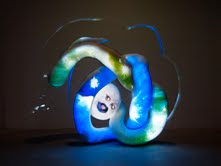 |
| Jean-Auguste-Dominique Ingres, La Baigneuse Valpinçon dite La grande baigneuse, 1808 |
It is difficult to describe the perfection of the bather’s silken skin in Ingres’ La Baigneuse Valpinçon dite La grande baigneuse (1808). And her flesh is so sensuous that it’s difficult to know where to stand in order to imbibe this perfection. Up close, I can almost smell it. At a distance the light touches her, gently as it nevertheless spills through an open window that we don’t see, but we know is there, behind the equally sumptuous folds of the rich green curtain. There is something about the falling folds of the curtain and the gathers of fresh bed linen on which she sits that makes the bather's back even more divine. For the luxurious rendering of light on the folds and fabric speaks to the vulnerability and luminosity of her back.
 |
| Ingres, Le Bain Turc, 1863 |
Ingres will paint the same skin, the same woman in the same pose again and again. He will repeat her for commissions, as a sketch and again in competed works such as le Bain Turc (1863) and never is she as beautiful as she is in La Baigneuse Valpinçon. And the secret of her beauity lies in what surrounds her : the folds of the curtain, the sensuous white bed linen that is so fresh I can smell its odor of clean air, and the light as it gently brushes her left shoulder. Together they create balance, and harmony in the painting as a whole, and infuse her skin with a delicate luminescence. Her back is so tender, her skin so inviting that it is all I can do to stop myself reaching out to touch her. I do not have the same response to Ingres’ other renditions of the same woman.
One of the most striking features of the painting are the cracks that articulate the surface of two hundred-year-old paint. But these cracks take nothing from the perfection of the bather's skin, and contrarily, somehow reinforce the delicacy of the figure. The weathered surface underlines the bather’s remove, keeping her safe in the seclusion of her thoughts, out of reach of both painter and viewer. Her pose, turned away and inwards, alone in her thoughts, apparently neither aware of nor disturbed by Ingres’ invasion of her private space, a space filled with the figure's stillness behind the cracks. I was at the Louvre on Friday night with a group of students, and when I drew their attention to the beauty and perfection of La Baigneuse Valpinçon, one wanted to see the painting as speaking to all of those discourses on voyeurism, and the woman’s body as object of the male gaze. But I don’t think so. Ingres’ bather is somehow above and beyond voyeurism; she is protected, if not by the cracks; she is kept safe inside the frame created by the curtain and the bed linen. Even if not literally, she is nevertheless held by these compositional elements. And the calmness of the painting, the stillness and silence of her pose, not sexualized, her back to the painter and the viewer seems to rescue her from such accusations. Ingres’ bather is, as art critic Robert Rosenblum has observed, in another time and place, beyond reality, out of reach of such base desires as those excited through ogling eyes.
 |
| Ingres, La petite Baigneuse - Intérieur d'harem, 1828 |
It is unusual for a man at this time to be painting what he finds inside the women’s baths, at least on such an intimate scale, with such realism. This makes Ingres' bathers oddities on many levels. When we think that on the floor below at the Louvre hang the history paintings of Delacroix and Géricault, the magnificent depictions of France, the conquerer, France the Republic breathing in power and victory, La Baigneuse Valpinçon is even more obscure. Her quiet, reflectiveness and the intimate vision of her body could not be more diametrically opposed to these works from the same era. Yet, even though we might wonder what Ingres was doing in the women’s baths, I didn’t and wouldn’t want to condemn him for this magical vision of earthly perfection.


















